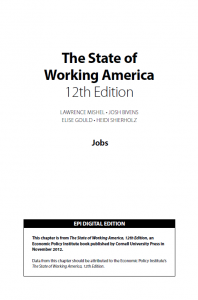 The State of Working America: Jobs
The State of Working America: Jobs
Economic Policy Institute
First published November 2012 in the Economic Policy Institute’s The State of Working America, 12th Edition.
Download ResourceEmployment is the foundation of family income and economic well-being for the vast majority of households that are not of retirement age. Even retired households need a strong past work history to enjoy economic security. It is through work that families have income to meet their material needs. Thus, whether the labor market is able to provide employment for willing workers is a key determinant of living standards.
Healthy job growth is growth that provides employment for all willing workers in a timely fashion. As we show, employment trends are driven by trends in aggregate demand (the total demand for goods and services in the economy). Simply put, jobs are created when demand for U.S. goods and services grows. The basic logic is straightforward—since workers provide goods and services, increasing demand for goods and services translates into job growth.
In periods of full employment, a healthy employment growth rate would be one that simply matches the growth rate of the labor force. But, contrary to assumptions often made by economists and policymakers, full employment is the exception rather than the rule in the U.S. labor market. An implicit message of this chapter is that ensuring healthy job growth requires an active macroeconomic policy that targets growth in aggregate demand sufficient to meet the growing supply of potential workers.
